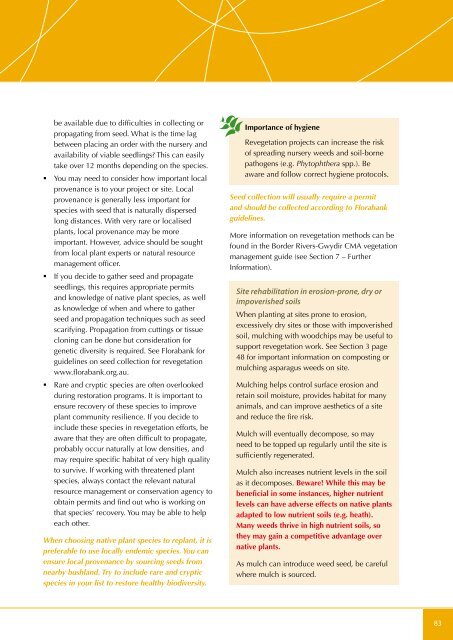Asparagus weeds - Weeds Australia
Asparagus weeds - Weeds Australia
Asparagus weeds - Weeds Australia
- No tags were found...
You also want an ePaper? Increase the reach of your titles
YUMPU automatically turns print PDFs into web optimized ePapers that Google loves.
e available due to difficulties in collecting orpropagating from seed. What is the time lagbetween placing an order with the nursery andavailability of viable seedlings? This can easilytake over 12 months depending on the species.• You may need to consider how important localprovenance is to your project or site. Localprovenance is generally less important forspecies with seed that is naturally dispersedlong distances. With very rare or localisedplants, local provenance may be moreimportant. However, advice should be soughtfrom local plant experts or natural resourcemanagement officer.• If you decide to gather seed and propagateseedlings, this requires appropriate permitsand knowledge of native plant species, as wellas knowledge of when and where to gatherseed and propagation techniques such as seedscarifying. Propagation from cuttings or tissuecloning can be done but consideration forgenetic diversity is required. See Florabank forguidelines on seed collection for revegetationwww.florabank.org.au.• Rare and cryptic species are often overlookedduring restoration programs. It is important toensure recovery of these species to improveplant community resilience. If you decide toinclude these species in revegetation efforts, beaware that they are often difficult to propagate,probably occur naturally at low densities, andmay require specific habitat of very high qualityto survive. If working with threatened plantspecies, always contact the relevant naturalresource management or conservation agency toobtain permits and find out who is working onthat species’ recovery. You may be able to helpeach other.When choosing native plant species to replant, it ispreferable to use locally endemic species. You canensure local provenance by sourcing seeds fromnearby bushland. Try to include rare and crypticspecies in your list to restore healthy biodiversity.Importance of hygieneRevegetation projects can increase the riskof spreading nursery <strong>weeds</strong> and soil-bornepathogens (e.g. Phytophthera spp.). Beaware and follow correct hygiene protocols.Seed collection will usually require a permitand should be collected according to Florabankguidelines.More information on revegetation methods can befound in the Border Rivers-Gwydir CMA vegetationmanagement guide (see Section 7 – FurtherInformation).Site rehabilitation in erosion-prone, dry orimpoverished soilsWhen planting at sites prone to erosion,excessively dry sites or those with impoverishedsoil, mulching with woodchips may be useful tosupport revegetation work. See Section 3 page48 for important information on composting ormulching asparagus <strong>weeds</strong> on site.Mulching helps control surface erosion andretain soil moisture, provides habitat for manyanimals, and can improve aesthetics of a siteand reduce the fire risk.Mulch will eventually decompose, so mayneed to be topped up regularly until the site issufficiently regenerated.Mulch also increases nutrient levels in the soilas it decomposes. Beware! While this may bebeneficial in some instances, higher nutrientlevels can have adverse effects on native plantsadapted to low nutrient soils (e.g. heath).Many <strong>weeds</strong> thrive in high nutrient soils, sothey may gain a competitive advantage overnative plants.As mulch can introduce weed seed, be carefulwhere mulch is sourced.83
















